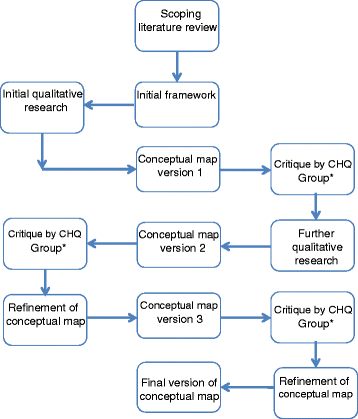Conceptualising patient empowerment: a mixed methods study
- PMID: 26126998
- PMCID: PMC4488113
- DOI: 10.1186/s12913-015-0907-z
Conceptualising patient empowerment: a mixed methods study
Abstract
Background: In recent years, interventions and health policy programmes have been established to promote patient empowerment, with a particular focus on patients affected by long-term conditions. However, a clear definition of patient empowerment is lacking, making it difficult to assess effectiveness of interventions designed to promote it. The aim in this study was to develop a conceptual map of patient empowerment, including components of patient empowerment and relationships with other constructs such as health literacy, self-management and shared decision-making.
Methods: A mixed methods study was conducted comprising (i) a scoping literature review to identify and map the components underpinning published definitions of patient empowerment (ii) qualitative interviews with key stakeholders (patients, patient representatives, health managers and health service researchers) to further develop the conceptual map. Data were analysed using qualitative methods. A combination of thematic and framework analysis was used to integrate and map themes underpinning published definitions of patient empowerment with the views of key UK stakeholders.
Results: The scoping literature review identified 67 articles that included a definition of patient empowerment. A range of diverse definitions of patient empowerment was extracted. Thematic analysis identified key underpinning themes, and these themes were used to develop an initial coding framework for analysis of interview data. 19 semi-structured interviews were conducted with key stakeholders. Transcripts were analysed using the initial coding framework, and findings were used to further develop the conceptual map. The resulting conceptual map describes that patient empowerment can be conceived as a state ranging across a spectrum from low to high levels of patient empowerment, with the level of patient empowerment potentially measurable using a set of indicators. Five key components of the conceptual map were identified: underpinning ethos, moderators, interventions, indicators and outcomes. Relationships with other constructs such as health literacy, self-management and shared decision-making are illustrated in the conceptual map.
Conclusion: A novel conceptual map of patient empowerment grounded in published definitions of patient empowerment and qualitative interviews with UK stakeholders is described, that may be useful to healthcare providers and researchers designing, implementing and evaluating interventions to promote patient empowerment.
Figures
References
Publication types
MeSH terms
LinkOut - more resources
Full Text Sources
Other Literature Sources



